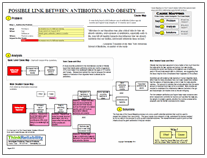By Kim Smiley
The lifecycle of the Guinea worm is the stuff of nightmares. This parasite is ingested by a host as larvae, mate and mature inside the host and then the adult female painfully emerges to lay her eggs. The adult female is between two to three feet long and the thickness of a spaghetti noodle. The only way to get rid of the parasite is to wrap it around a stick and slowly pull it out, a process that takes several weeks or even months.
 Individuals who are infected by this parasite can suffer for months, making it difficult to work and feed their families. There is no immunity to Guinea worms so it’s possible for people to suffer year after year if they continue to ingest the larvae of the Guinea worms. There is also no drug to treat Guinea worm disease and there is no vaccine that prevents infections.
Individuals who are infected by this parasite can suffer for months, making it difficult to work and feed their families. There is no immunity to Guinea worms so it’s possible for people to suffer year after year if they continue to ingest the larvae of the Guinea worms. There is also no drug to treat Guinea worm disease and there is no vaccine that prevents infections.
But there is hope in the fight against this excruciating disease. The number of cases of Guinea worm disease has decreased dramatically. In 1986 there were an estimated 3.5 million cases of Guinea worm disease spread across 21 countries in Asia and Africa. In 2011, there were only 1,058 reported cases of Guinea worm disease in four African countries.
How was this possible? The first step in answering that question is to understand more about the disease. The problem of Guinea worm disease can be illustrated by building a Cause Map, an intuitive root cause analysis format. By asking “Why” questions, causes can be added to the Cause Map and the problem can be analyzed. Why are people getting the disease? People are drinking water that is contaminated with copepods, also called water fleas, which are infested with larvae of Guinea worms. There is also typically no other supply of safe drinking water and the water wasn’t treated or filtered prior to consumption.
Painful blisters form when the female Guinea worm emerges from the body and people put their sores into the same water used for drinking (because it is usually the only water available) to help relieve the burning sensation. The female Guinea worm then releases hundreds of thousands of guinea worm larvae once she senses water. Guinea worm larvae is eaten by the water fleas. The infected water fleas are small and ingested along with the water, which restarts the whole process.
This process had been going on for thousands of years, affecting millions and millions of people. Its remains have even been found in Egyptian mummies. But simple changes have nearly eliminated the disease. In fact, Guinea worm disease is predicted to be the first human disease ever eradicated without a vaccine and only human disease to be eradicated other than small-pox.
Relatively simple changes have made all the difference in the world. People were educated about how to prevent the disease. Millions of straws with filters were handed out to villagers to strain out the infected water fleas and prevent the parasite from entering the body. Efforts were also made to treat water with larvicide and provide access to uncontaminated drinking water.
Without new hosts, the Guinea worm larvae died. Once the lifecycle was broken, the disease disappeared from many regions. There are now only four countries that reported any cases of the disease last year, the vast number being in war torn South Sudan where public health efforts have been difficult to sustain.
Click on “Download PDF” above to view a high level Cause Map of this issue









